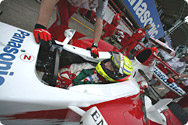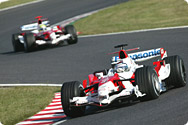Thank you as always for your support. Here is my report from the Japanese Grand Prix-the Panasonic Toyota Racing home country race that I'm sure you have been anticipating as much as we have.
Heading to Suzuka with improved reliability
We brought a package of new aero items with us to Shanghai last week, so our only significant aerodynamic changes for the Japanese GP were to our brake ducts. The brake ducts changes reflect the fact that Suzuka is slightly easier on brakes than Shanghai.
 |
 |
| Basically the team is using the same aero package as the one used in the Chinese Grand Prix, with the exception of changes to the brake ducts, comprising a "Suzuka spec" for the Japanese Grand Prix. Having a "fresh" engine on its first race, the team did make some revisions to ensure better reliability compared to the engine used last week. |
|
 |
In the last race, both Jarno Trulli and Ralf Schumacher retired early due to engine trouble. We have brought our most reliable spec engine to the Japanese Grand Prix, so we don't think there will be a recurrence of engine trouble. The original plan was to bring the Shanghai engines here to Japan for their second race, but the performance of the new engines is fundamentally unchanged. We have made some basic improvements to engine reliability, considering the factors that contributed to the problems last week.
In Japan, the race officials announced a refueling level of 3kg per lap for cars reaching Q3 (third qualifying session). Based on past results and improved fuel efficiency of the V8 engines being used this year, we project that 3kg per lap will provide us with some fuel leeway. This means it's important to make it through to Q3 to be able to take advantage of this benefit.
Friday yielded testing for both wet and dry tires
We prepared for rain all day Friday, but we were able to run on dry tires during the last part of the afternoon session. Our calculations included the chance of rainy weather through Saturday morning, and we predicted a wet track even if the rain stopped. With that, I think the biggest benefit of the session was that we were able to drive under conditions similar to qualifying and the actual race.
Reflecting back over Friday as a whole, we normally only do installation laps (laps to confirm car functions) during the morning session anyway, and given the rain situation, our plan was to drive a short distance and then call an end to the session. We ended up using extreme weather tires (tires with deep grooves used during heavy rain), but we were able to build confidence that we could hold our own if the weather conditions continued to be rainy like Friday morning.
| |
 |
 |
Making completely smooth progress up through qualifying, Ralf and the team captured their best position of the year at P3 on the starting grid. Jarno qualified P4 on the grid, ensuring terrific starting positions for both cars, and making for high expectations. |
 |
At the beginning of afternoon practice, we thought we might have a chance to use dry tires sometime during the last half of the session. As predicted, circumstances during the first half of the session dictated standard wet tires, so we only went through two test drives. Later, conditions dried out as we expected, so we switched over to dry tires and went back out on the track at the 40 minute mark.
As usual, we had both drivers doing tire comparisons, but as of that stage in the day, it looked like either of the tire specs would work. We decided to test once more during Saturday morning practice, at which point we would make our tire selection for qualifying and the race. The cars themselves were in good working order.
Right on target! Capturing our highest qualifying results this season in front of our home country fans
We wanted to secure the best starting position possible going into the race, and I think we captured the exact results we wanted, qualifying at P3 and P4. I think it was wonderful that we were able to capture our best qualifying results of the year at the Japanese GP.
 |
 |
| Both cars were off to a good start, showing no signs of the slowness off the grid that had hampered the team several times during the season. Ralf protected his position at third through the first corner, while Jarno lost maneuvering room, settling for fifth position during the first stint of the race. |
|
 |
We tested the dry tires during the last part of the second Friday free practice session, but we had both drivers test tires again during Saturday's session (the third practice session of the weekend). At that stage, we were finally able to see some trends pointing us to the preferred tire, so we had Ralf come in and change to that tire spec for one more test. Meanwhile, Jarno had been driving the entire time on the spec we selected. In the end, we decided not to put new tires on his car so we could save them for later. This was the reason that Ralf was able to record the 2nd fastest lap time during the session, while Jarno was only 20th. Both Jarno and Ralf had a good feeling about their cars, giving them solid confidence going into qualifying.
Our results during afternoon qualifying were an exact reflection of our confidence going in. We normally make two time attack runs during Q2 (second qualifying session), but with such a good times recorded during the first attack, we stopped at just the one. This helped us save the tires for later.
Of course, we had no idea what would happen until the race actually started. We didn't think we could win going away, but we did feel just a little entitled to a strong finish.
Frustration with a last-stint speed fall-off tempers the joy of having both cars finish in the points for the first time this season
While we were happy to have both cars finish in the points for the first time this season, we were also very disappointed that we couldn't finish as high as we had hoped. I think there are still many issues we need to take care of. Rather than feeling joy at having both cars in the points, the results were more of a let-down for the team.
We have identified two issues that we need to resolve to finish better in the races. One is for us to get better starts. The other is to be able to drive at our pace throughout the entire race. In the first corner, Jarno ran out of room, and Alonso was able to come around from behind. But even so, I would say our start in the Japanese GP was close to a passing grade for us.
| |
 |
 |
Jarno moved ahead of Ralf after the first round of pit stops, but fell off the pace after the second pit stop, losing position together with Ralf. Still, both cars were able to finish in the points-a first for this season. |
 |
Our problem was with the second issue-our race pace. We were running well until the second stint, when Jarno reported that his car had started to oversteer. We made a wing adjustment for Jarno, and sent him out for the third stint. Having made the adjustment, Jarno reported the car now was understeering, the tires were showing graining (fraying wear on the tires), and for several laps we couldn't improve our times. As Ralf was right behind Jarno, this development slowed Ralf as well, and both cars ended up losing position.
I think everyone had high expectations for Panasonic Toyota Racing at this Japanese Grand Prix. My true feeling is one of sadness that we could not capture a spot on the podium for our supportive fans. But looking over the entire weekend, I think we have made solid progress with our car, and the Panasonic Toyota Racing team is more confident than ever. Now that we have identified the issues, we want to be able to show the world the speed of our car one more time at the last race of the year in Brazil. Please continue to cheer us on!
|